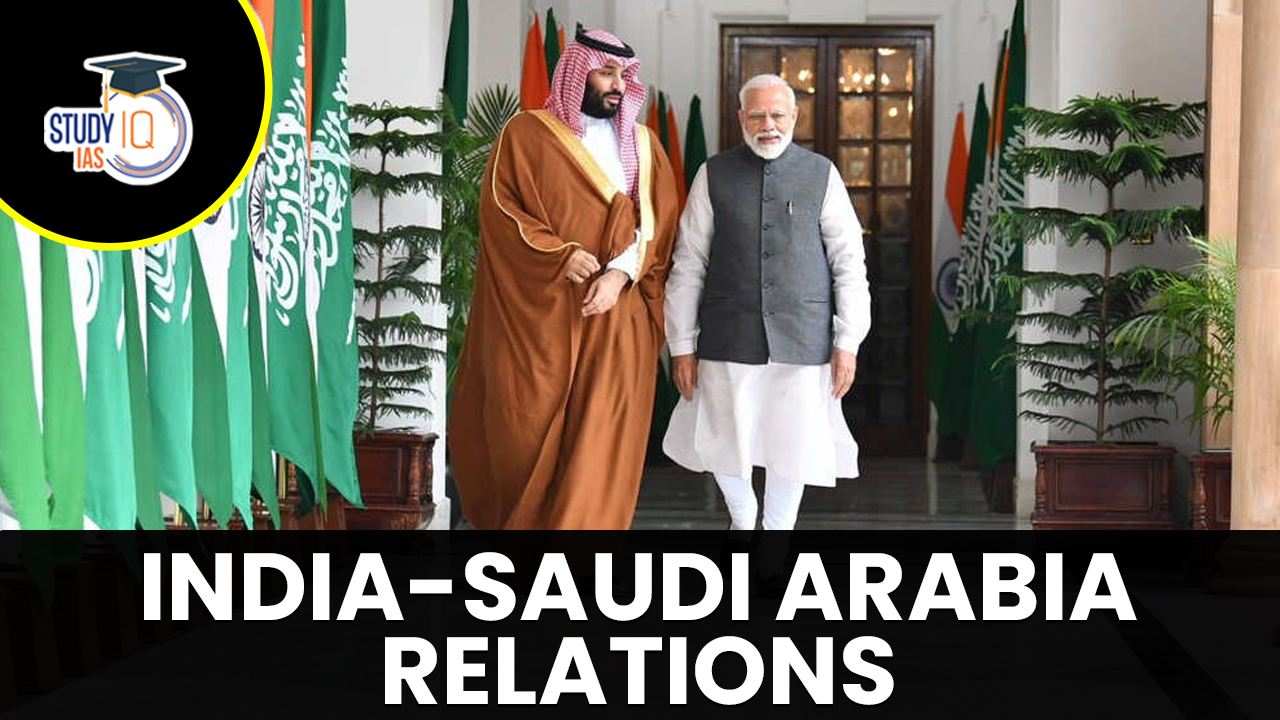Table of Contents
Context: The Crown Prince Mohammed Bin Salman of Saudi Arabia paid his state visit to India recently.
More on News
During the visit, both sides acknowledged their partnership crucial for regional stability.
- Launch of India-Middle East-Europe Economic Corridor: Two days before the state visit, India and Saudi Arabia jointly launched the India-Middle East-Europe Economic Corridor, aiming to enhance economic growth, particularly in the energy sector and digitization, while connecting India, West Asia, and Europe.
- India-Saudi Strategic Partnership Council (SPC): Both leaders co-chaired the first meeting of the India-Saudi Strategic Partnership Council, which was established in October 2019 to strengthen bilateral ties.
- Areas of Cooperation: The discussions during the visit covered various areas of cooperation, including defence, energy, security, education, technology, transportation, healthcare, tourism, culture, space, and semiconductors.
- West Coast Refinery Project: Both sides expressed full support for the West Coast refinery project, a trilateral initiative involving ARAMCO, ADNOC, and Indian companies.
- India-GCC Free Trade Agreement: India and Saudi Arabia agreed to work on the India-GCC Free Trade Agreement (FTA), potentially enhancing trade ties with the Gulf Cooperation Council (GCC) countries.
- Bilateral Agreements: Eight agreements were sealed during the visit, covering areas such as anti-corruption cooperation, banking, technology, and archival research collaboration.
- Energy Partnership: India and Saudi Arabia announced the upgrade of their energy ties to a “comprehensive energy partnership,” with the establishment of a monitoring committee to ensure the progress of the refinery project.
- Reliable Oil Supplies: Saudi Arabia assured India of its commitment to remain a reliable partner and exporter of crude oil supplies.
- Defence and Anti-Terror Cooperation: The joint statement emphasized strengthening cooperation in defence and anti-terrorism efforts, including preventing access to missiles and drones for terrorist activities.
- Humanitarian Assistance: The discussions also covered humanitarian assistance to Yemen and a shared desire for a government in Afghanistan that represents all segments of the Afghan population, indicating support for an inclusive government in Afghanistan.
India Saudi Ties
Historical Background:
- India and Saudi Arabia enjoy cordial and friendly relations reflecting the centuries old economic and socio-cultural ties.
- The establishment of diplomatic relations in 1947 was followed by high-level visits from both sides.
Recent visits
- Manmohan Singh (then Indian PM) visited Saudi Arabia in 2010 and the ‘Riyadh Declaration’ was signed during the visit that elevated the bilateral relationship to a ‘Strategic Partnership’.
- During the visit in 2016, King Salman conferred the Kingdom’s highest civilian honour– ‘Sash of King Abdulaziz’, on Prime Minister Modi.
- During the visit of Crown Prince Salman to India in February 2019, the Kingdom decided to invest approximately US $100 billion in India.
- During the visit of PM Modi to Riyadh in 2019, the Strategic Partnership Council (SPC) Agreement was signed.

India-Saudi Strategic Partnership Council (SPC)
- The pact to establish the SPC was signed during PM Modi’s visit to Saudi Arabia in October 2019.
- It aimed to establish a high-level council to steer the Indo-Saudi relationship.
Pillars
- The SPC has two main pillars:
- Committee on Political, Security, Social and Cultural Cooperation; and
- Committee on Economy and Investments.
- Both sub-committees have four functional levels of engagements:
- Summit level (Prime Minister & Crown Prince);
- Ministerial-level;
- Senior Officials’ Meetings; and
- Joint Working Groups (JWGs).
- India is the fourth country with which Saudi Arabia has formed such a strategic partnership, after the UK, France and China.
Economic Cooperation between India and Saudi Arabia
- Trade
- In 2022-23, bilateral trade between India and Saudi Arabia reached an all-time high of $52.75 billion.
- India’s exports to Saudi Arabia were $10.7 billion, up from $8.8 billion in 2021-22.
- India is Saudi Arabia’s second largest trading partner whereas Saudi Arabia is India’s fourth largest trading partner.
Major exports India to Saudi Arabia are: Cereals, Spices, Machinery, Iron or steel products, Organic chemicals, Meat, Vehicles, Ceramic products, electronic equipment, and Clothing (not knit or crochet).
Major imports from Saudi to India: Oil, organic chemicals, plastics, fertilizers, gems, precious metals, aircraft, spacecraft, inorganic chemicals, aluminum, copper, other chemical goods.
- Investment
- Indian investments in the Kingdom of Saudi Arabia have reached approximately USD 2 Billion.
- Saudi Arabia is the 18th largest investor in India with investments amounting to $3.14 billion (March 2022).
- During Saudi Crown Prince’s visit to India in February 2019, he announced that the Kingdom would be investing US $100 billion in India in diversified sectors.
Energy Partnership between India and Saudi Arabia
- Energy cooperation forms a central pillar of the Indo-Saudi bilateral ties. Saudi Arabia is a key partner for India for ensuring energy security.
- It remained India’s third largest Crude and Petroleum products sourcing destination for FY 2022-23.
- India Imported 39.5 MMT of crude oil from Saudi Arabia, in FY23, accounting for 16.7 % of its total crude imports.
- Additionally, India’s LPG imports from Saudi Arabia stood at 7.85 MMT and accounted for 11.2% of its total petroleum product imports in FY 23.
Defence Partnership between India and Saudi Arabia
- In a landmark visit, the Indian Chief of Naval Staff, General Manoj Mukund Naravane visited Saudi Arabia in December 2020.
- As on date, two editions of the bilateral naval exercise “Al Mohed al Hindi” have been concluded.
- Additionally, both sides are also having close cooperation in the domain of defence industries and capacity building.
Indian Community in Saudi Arabia
- The approximately 2.2 million strong Indian community is the largest expatriate community in the Kingdom.
- 7% of the population of Saudi Arabia comprise of Indians who have a large part in the economic growth of the country.
- During PM’s visit to Riyadh in October 2019, the two sides announced that India’s e-Migrate system would be integrated with the Kingdom’s e-Thawtheeq system to streamline the migration process for workers.
- The annual Hajj pilgrimage is another important component of Indo-Saudi bilateral relations.
- During Crown Prince’s visit to New Delhi in February 2019, it was announced that India’s Hajj quota would be increased by 24,975 in 2019, enabling 2,00,000 Indians to perform Hajj in August 2019.
Collaboration between India and Saudi Arabia during COVID-19
- Throughout the pandemic, both nations have been sharing national experiences and supporting each other.
- In February and March, 2021, in two separate consignments, India provided 4.5 million COVISHIELD vaccines to the Kingdom.
- On the other hand, during the second wave, the latter provided India with COVID-relief material, particularly liquid oxygen.
Challenges in the ties
- Iran and Saudi Arabia have ongoing tensions despite Iran’s agreement with the P5+1 countries. This is concerning for the entire region because both countries have their areas of influence.
- Saudi Arabia traditionally has a close relationship with Pakistan, involving cooperation in areas like oil, financial credits, and Wahhabism. However, Saudi Arabia is uneasy about India’s growing ties with Iran. India hopes that Saudi Arabia will use its influence to prevent Pakistan from supporting terrorists targeting India.
- Many Indians working in Saudi Arabia are facing challenges due to a significant increase in the ‘expatriate dependent fee’ since July 1, 2017. This fee is causing many Indian expatriates to send their families back to India.
- Saudi Arabia has been actively implementing the ‘Nitaqat’ nationalization program for over three years. This program aims to replace foreign workers with Saudi youth in various industries, leading to a decrease in wages for expatriates.
- Migrant workers in Saudi Arabia, as well as in other Gulf countries, face difficulties due to the archaic Kafala system. This system requires migrant workers to have a sponsor in the country where they work, making them vulnerable to exploitation by their employers.


 Fiscal Slippage, Causes and Implications
Fiscal Slippage, Causes and Implications
 Serious Fraud Investigation Office (SFIO...
Serious Fraud Investigation Office (SFIO...
 Article 142 of Indian Constitution, Sign...
Article 142 of Indian Constitution, Sign...





















